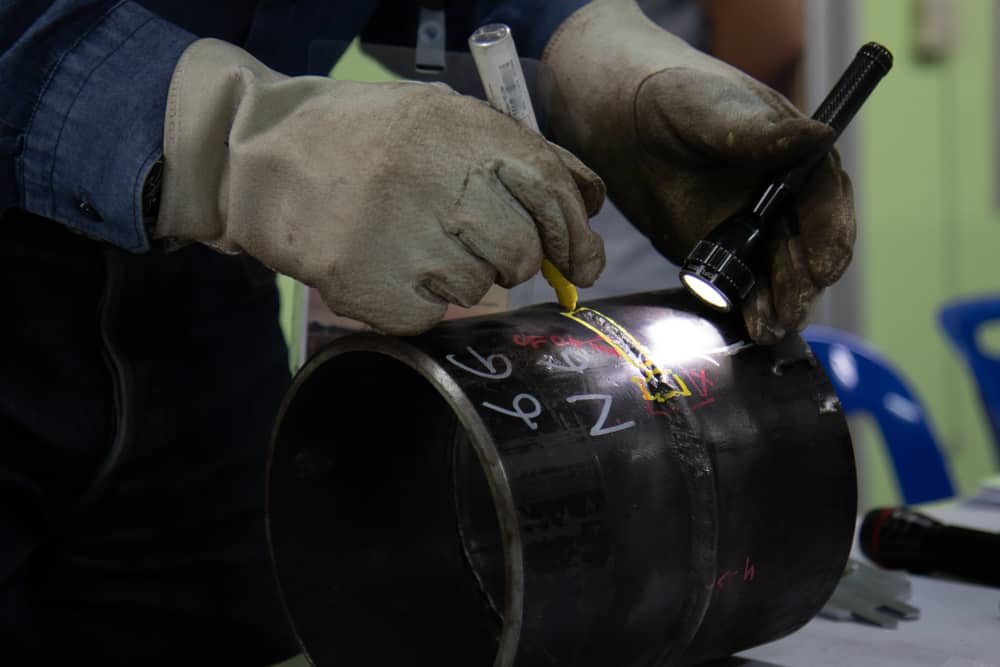Comprehensive Summary of Pipe Welding Inspection Treatments
In the realm of pipe building and construction, making certain the honesty and security of bonded joints is vital. Pipe welding examination procedures play an important function in guaranteeing that bonded connections fulfill strict industry requirements and specs. From precise pre-welding examinations to thorough post-weld evaluations, a well-defined assessment process is important for keeping the structural stability of pipes. Comprehending the complexities of welding inspection procedures is not only a governing need yet also an essential aspect of supporting the integrity of these critical frameworks.
Pre-welding Inspection Preparations
Prior to commencing the welding procedure, thorough pre-welding inspection prep work are vital to make certain the stability and high quality of the weld joint. These preparations involve a precise evaluation of the products to be bonded, the welding tools, and the work environment. The materials need to be inspected for any type of defects, pollutants, or disparities that can jeopardize the weld. This includes monitoring for proper product grades, measurements, and surface problems. Pipeline Welding Inspection. In addition, the welding tools requires to be checked to confirm that it remains in great functioning problem, adjusted properly, and appropriate for the details welding procedure. Any concerns with the tools should be addressed immediately to stop flaws in the weld. Finally, the workplace should be evaluated for cleanliness, correct ventilation, and precaution to guarantee a favorable setting for the welding procedure. By performing detailed pre-welding evaluation prep work, possible problems can be identified and dealt with early, resulting in high-quality and reliable weld joints.
Welding Procedure Qualification
Extensive pre-welding inspection preparations lay the structure for the crucial procedure of Welding Treatment Qualification, making certain the honesty and quality of the weld joint. Welding Treatment Certification (WPQ) is a vital step in the welding procedure that entails testing and licensing welding treatments to guarantee they fulfill particular requirements and needs. The WPQ procedure commonly includes welding treatment specification development, welding treatment certification screening, and documents of the outcomes.
During welding procedure spec development, important information such as the welding procedure, welding products, joint layout, and welding criteria are specified to create a comprehensive treatment. Ultimately, welding treatment qualification screening is performed to verify the suggested treatment's honesty. This testing frequently entails welding examination coupons that undergo different mechanical and non-destructive examinations to evaluate the weld's top quality and adherence to the defined requirements.
In-process Weld Evaluation
During the welding procedure, in-process weld assessment plays an important duty in making sure the top quality and honesty of the weld joint - Pipeline Welding Inspection. This kind of evaluation why not look here entails monitoring the welding criteria, assessing the weld bead development, and detecting any type of possible issues or stoppages as they take place. By conducting in-process weld evaluations, welding drivers can promptly address any type of problems that might arise, thereby guaranteeing and avoiding additional defects that the final weld fulfills the required specifications
Common approaches made use of for in-process weld assessment include visual examination, liquid penetrant screening, magnetic bit screening, ultrasonic testing, and radiographic testing. Overall, in-process weld evaluation is vital for keeping the quality and integrity of welded pipes.
Non-destructive Testing (NDT)
Non-destructive Testing (NDT) is an important method employed in pipe welding assessment to evaluate the honesty of weld joints without causing damages to the bonded framework. By using different NDT strategies, examiners can assess the top quality of welds and determine any type of issues or suspensions that may endanger the architectural try these out strength of the pipe. Common NDT methods utilized in pipe welding examination include Radiographic Testing (RT), Ultrasonic Screening (UT), Magnetic Bit Evaluating (MPT), Liquid Penetrant Testing (LPT), and Visual Testing (VT)
RT includes the usage of X-rays or gamma rays to generate photos of the inner structure of the weld, allowing inspectors to identify flaws such as porosity, fractures, or incomplete fusion. Additionally, VT involves visual evaluation of welds to identify any kind of visible blemishes.
Post-weld Inspection and Documents

Paperwork of post-weld inspection searchings for is important for preserving quality assurance documents and making sure conformity with market criteria and regulations. Detailed reports ought to consist of information concerning the assessment techniques utilized, the area and nature of click this any type of problems located, and any kind of restorative activities taken - Pipeline Welding Inspection. Proper documentation not only functions as a document of the weld's top quality yet also help in future maintenance and inspection processes
Conclusion

Finally, pipeline welding evaluation treatments play an important function in guaranteeing the high quality and integrity of welds. From pre-welding inspections to post-weld paperwork, each action is vital in maintaining the safety and effectiveness of pipelines. By adhering to well-known procedures and conducting complete assessments, possible problems can be recognized and addressed before they lead to costly repair work or failures. On the whole, adherence to proper examination procedures is essential to the success of pipeline welding projects.
From careful pre-welding evaluations to detailed post-weld analyses, a distinct inspection procedure is vital for preserving the architectural stability of pipelines. By carrying out in-process weld inspections, welding drivers can quickly resolve any kind of concerns that might arise, thereby avoiding additional problems and guaranteeing that the final weld fulfills the needed specifications.
Typical approaches utilized for in-process weld examination consist of visual inspection, liquid penetrant testing, magnetic fragment screening, ultrasonic screening, and radiographic testing.Non-destructive Testing (NDT) is a vital approach employed in pipeline welding evaluation to evaluate the stability of weld joints without causing damages to the bonded structure. Post-weld evaluation includes various techniques to assess the welds for defects, including aesthetic inspection, dye penetrant screening, magnetic particle testing, ultrasonic testing, and radiographic testing.
Comments on “Professional Pipeline Welding Inspection Providers: Making Certain Security and Conformity”